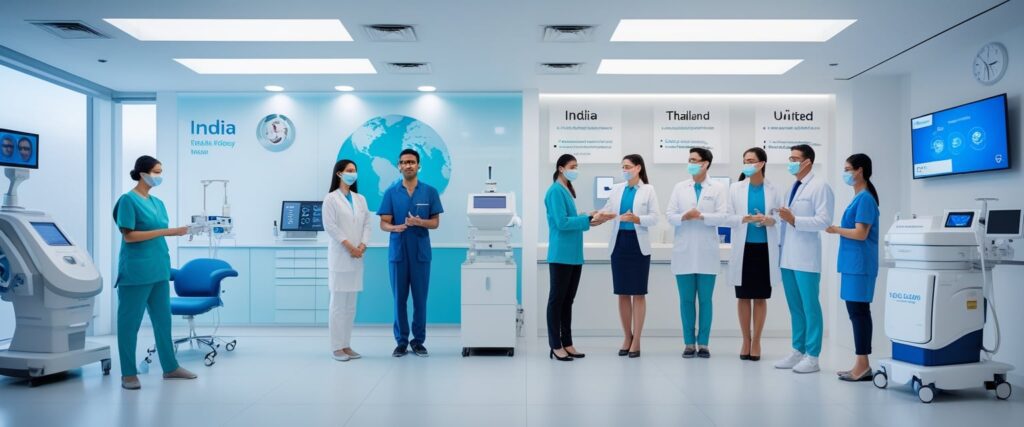In recent years, the number of people exploring advanced eye treatments abroad has risen significantly — and one of the most discussed topics among global patients is LASIK Eye Surgery Cost in USA, Turkey, Thailand & India: Comparison, Success & Insights. This life-changing procedure not only enhances vision but also offers freedom from glasses or contact lenses.

Understanding the cost differences, success rates, and overall experience across these top medical destinations helps patients make informed choices. Through LASIK Eye Surgery Cost in USA, Turkey, Thailand & India: Comparison, Success & Insights, readers can clearly see how each country combines modern technology, affordability, and high medical standards to deliver exceptional vision correction results.
Table of Contents
LASIK Eye Surgery Cost in USA, Turkey, Thailand & India
LASIK eye surgery reshapes the cornea with a precision laser to correct vision problems like nearsightedness, farsightedness, and astigmatism. It offers a long-term alternative to glasses or contacts and is one of the most common elective procedures worldwide. LASIK typically costs between $1,900 and $3,000 per eye in the United States, while trusted clinics in countries like Turkey, Thailand, and India perform the same procedure for 40–70% less, according to Bookimed’s 2025 LASIK cost guide.
Turkey often ranks as the most affordable option, with prices starting around $900 per eye and packages that include exams, surgery, and follow-up care. Thailand and India also attract many international patients with skilled ophthalmologists and advanced technology at lower costs. While LASIK is highly effective, it isn’t 100% successful for everyone. Most people achieve 20/20 vision or better, though some may need a touch-up years later to maintain sharp vision.

Many people wonder if LASIK lasts permanently or if it can be repeated after a decade. The results generally last for many years, but natural aging can still affect eyesight. In some cases, a second procedure is possible. From celebrities like Tiger Woods and Nicole Kidman to thousands of everyday patients in Istanbul, Bangkok, and New Delhi, successful LASIK stories continue to show how this quick surgery can deliver lasting visual freedom.
Understanding LASIK Eye Surgery
LASIK eye surgery uses precise laser technology to reshape the cornea and correct common vision errors such as nearsightedness, farsightedness, and astigmatism. It offers a long-term alternative to glasses or contact lenses for many people seeking sharper vision and greater convenience.
What Is LASIK Eye Surgery?
LASIK (Laser-Assisted In Situ Keratomileusis) is a type of refractive surgery designed to improve how light focuses on the retina. It treats myopia (nearsightedness), hyperopia (farsightedness), and astigmatism, which occur when the cornea’s shape prevents clear focus.
The procedure begins with a detailed eye exam to ensure the patient’s cornea is thick enough and healthy. During surgery, the doctor creates a thin flap on the cornea’s surface using a microkeratome blade or a femtosecond laser.

After lifting the flap, an excimer laser reshapes the corneal tissue to correct the refractive error. The flap is then repositioned to heal naturally without stitches. Most patients notice improved vision within 24 hours, and many achieve 20/20 vision or better.
How LASIK Corrects Vision Problems
The cornea plays a key role in focusing light. When its curvature is irregular, light rays do not meet correctly on the retina, causing blurred vision. LASIK reshapes the cornea so that light focuses precisely, improving clarity.
For myopia, the laser flattens the cornea to reduce its focusing power. For hyperopia, it steepens the cornea to increase focus. In cases of astigmatism, the laser smooths uneven areas to create a more regular curve.

LASIK differs from PRK (Photorefractive Keratectomy), another laser eye surgery, because LASIK preserves the corneal surface layer, leading to faster recovery and less discomfort. Patients usually resume normal activities within a few days.
Key Technologies and Techniques in LASIK
Modern LASIK uses advanced systems for accuracy and safety. Femtosecond lasers create corneal flaps with greater precision than traditional blades, reducing complications. Wavefront-guided and topography-guided LASIK customize the laser pattern to each person’s unique eye shape.
A comparison of common LASIK tools:
| Technology | Function | Benefit |
|---|---|---|
| Microkeratome | Mechanical blade to create flap | Reliable and cost-effective |
| Femtosecond laser | Laser-based flap creation | Higher precision, fewer risks |
| Excimer laser | Reshapes cornea | Accurate correction of refractive errors |
These innovations have made LASIK one of the most refined vision correction procedures, offering predictable results and high patient satisfaction.
LASIK Eye Surgery Cost Comparison: USA, Turkey, Thailand & India
LASIK eye surgery prices vary widely depending on location, surgeon expertise, and the type of laser technology used. Patients often compare options across countries to balance cost, safety, and quality before choosing where to have their vision corrected.
Average LASIK Costs by Country
In the United States, LASIK typically costs between $1,900 and $3,000 per eye, depending on whether the clinic uses standard or bladeless technology. Some U.S. clinics advertise lower prices, but these often exclude pre-op exams or follow-up visits.
In Turkey, patients usually pay $900 to $1,500 per eye, according to Bookimed’s 2025 analysis. These prices often include exams, surgery, medication, and short-term accommodation.

Thailand offers LASIK for about $1,000 to $1,500 per eye, with many clinics using advanced femtosecond lasers. India remains one of the most affordable destinations, where LASIK can cost as little as $500 to $1,200 per eye, depending on the city and surgeon experience.
| Country | Typical Cost (per eye, USD) | Common Inclusions |
|---|---|---|
| USA | $1,900–$3,000 | Surgery only, limited follow-up |
| Turkey | $900–$1,500 | All-inclusive packages |
| Thailand | $1,000–$1,500 | Advanced laser tech |
| India | $500–$1,200 | Affordable local pricing |
Factors Affecting LASIK Pricing
LASIK cost depends on several key factors. The type of laser technology—standard, femtosecond, or wavefront-guided—can significantly change the price. Clinics that use the latest FDA-approved systems usually charge more.
The experience of the eye surgeon also affects cost. Highly trained ophthalmologists with thousands of procedures often charge higher fees.
Additional costs come from pre-operative testing, post-operative care, and facility accreditation. Clinics accredited by international bodies such as JCI or ISO may have higher base prices but often maintain stricter safety standards.

Geographic differences in labor, equipment, and overhead costs further explain why LASIK is cheaper in countries like Turkey or India compared to the U.S.
Which Country Offers the Cheapest LASIK?
Among the four countries, India generally offers the lowest LASIK prices, followed closely by Turkey. Patients can expect to save up to 60% compared to U.S. clinics.
According to Universal Medical Travel, India’s competitive cost is due to lower medical expenses and high procedure volume. Turkish clinics combine affordability with international accreditation, making them popular among overseas patients.

While Thailand’s prices are slightly higher, its hospitals often feature advanced laser platforms and English-speaking staff, attracting patients from nearby regions. The U.S. remains the most expensive due to higher labor and facility costs, though patients value local convenience and follow-up accessibility.
Medical Tourism for LASIK Eye Surgery
Many patients now travel abroad for eye surgery to reduce expenses while maintaining quality care. Medical tourism for LASIK is especially popular in Turkey, Thailand, and India because these countries combine modern laser technology with experienced surgeons.
Clinics in Istanbul, Bangkok, and New Delhi often provide all-inclusive packages, covering exams, surgery, hotel stays, and airport transfers. This approach simplifies the process for international patients.
Travelers should verify clinic credentials and surgeon qualifications before booking. Choosing a JCI-accredited hospital or one with internationally trained ophthalmologists helps ensure safety and reliable outcomes.

Medical tourism not only lowers costs but also gives patients access to advanced equipment and short waiting times compared to many Western countries.
Success Rates, Longevity, and Repeat LASIK Procedures
LASIK surgery continues to show strong success in vision correction, with high satisfaction and low complication rates. Long-term studies confirm that most patients maintain improved vision for many years, though some may need enhancements or repeat procedures later in life.
Is LASIK 100% Successful?
LASIK is highly effective but not 100% successful for every patient. Most studies show 90–99% of patients achieve 20/20 or better vision, and nearly all reach at least 20/40, which is sufficient for driving. According to Vision Center, serious complications occur in less than 1% of cases.
Patient satisfaction remains very high—about 95–99% report being pleased with their results. Factors such as corneal thickness, prescription stability, and pre-surgery eye health affect outcomes.

Some patients may still need glasses for specific tasks, like reading, especially as they age. While not perfect, LASIK’s precision and safety make it one of the most successful elective surgeries performed by ophthalmologists worldwide.
Does LASIK Last Permanently?
LASIK permanently reshapes the cornea to correct refractive errors. The structural change does not wear off, but natural aging of the eye can alter vision over time. Studies show that most people maintain sharp vision for 10 years or more after surgery.
A review from Vision Center notes that over 90% of patients stay within ±2.0 diopters of their intended correction after a decade. Slight regression may occur in those with high prescriptions or age-related changes like presbyopia.

LASIK does not prevent these natural changes, but it remains a long-lasting solution for distance vision correction. Periodic eye exams help track any shifts in vision and determine if further treatment is needed.
Can You Get LASIK Again After 10 Years?
Yes, repeat LASIK—often called an enhancement—can be done if vision changes after the first procedure. Ophthalmologists typically wait until the patient’s prescription stabilizes again before performing another laser correction.
Enhancements are uncommon, with studies showing less than 5% of patients need them over time. The decision depends on corneal thickness, previous surgical data, and current eye health.

If the cornea is too thin for another LASIK, other options like PRK may be used. A follow-up eye exam helps determine candidacy for repeat treatment and ensures the cornea remains safe for additional reshaping.
Post-Operative Care and Long-Term Outcomes
Proper post-operative care plays a major role in maintaining long-term LASIK results. Patients usually use prescribed eye drops to reduce dryness and prevent infection for several weeks after surgery.
Most people notice improved vision within 24 hours, but full stabilization can take a few months. Regular follow-up visits allow the ophthalmologist to check healing and vision accuracy.

Long-term data from Vision Center show that modern LASIK technology—such as wavefront-guided and femtosecond lasers—has reduced complications like glare or halos to under 1%. With consistent care and routine eye exams, LASIK outcomes remain stable and highly reliable over many years.
Real-Life LASIK Success Stories and Celebrity Experiences
People from different backgrounds have shared strong results after LASIK eye surgery. Many report clearer vision, faster recovery, and long-term satisfaction when treated by experienced surgeons and qualified ophthalmologists. Real stories also show how both everyday individuals and celebrities have benefited from this procedure.
Examples of Successful LASIK Surgeries in USA, Turkey, Thailand & India
In the United States, patients often describe improved clarity and convenience after LASIK. For example, real patients on the Refractive Surgery Council site shared how they no longer rely on glasses or contacts for daily tasks. Many credit skilled ophthalmologists and advanced laser technology for their success.
In Turkey, medical tourism has made LASIK more affordable. Clinics in Istanbul attract patients with competitive pricing and internationally trained eye surgeons. Many foreign patients report outcomes similar to those in the U.S., with minimal downtime and lasting vision correction.
In Thailand, hospitals in Bangkok and Phuket are known for modern equipment and English-speaking ophthalmologists. Patients often combine surgery with short recovery vacations. Reviews highlight clear post-surgery vision and strong patient care standards.

In India, LASIK is performed by experienced surgeons in cities like Delhi, Mumbai, and Chennai. The lower cost and high-quality equipment make it a popular choice. Patients often note professional care and precise results comparable to global standards.
Celebrities Who Have Undergone LASIK Eye Surgery
Many celebrities have chosen LASIK to improve their vision and performance. Tiger Woods, for example, had LASIK early in his career, which helped him see more clearly on the golf course.
Brad Pitt, Jessica Simpson, and LeBron James have also publicly discussed their LASIK experiences. They often mention the convenience of living without glasses or contacts and the confidence gained from sharper vision.

Celebrities value trusted ophthalmologists who use advanced laser systems. Their positive results help normalize LASIK as a safe and effective procedure for both public figures and everyday patients.
Conclusion
Choosing where to undergo LASIK treatment depends on finding the right balance between quality, safety, and affordability — and that’s where LASIK Eye Surgery Cost in USA, Turkey, Thailand & India: Comparison, Success & Insights becomes an invaluable guide. From the premium medical expertise of the USA to the cost-effective excellence of Turkey, Thailand, and India, each destination offers unique advantages for patients seeking clear vision. By comparing procedures, technologies, and long-term outcomes, LASIK Eye Surgery Cost in USA, Turkey, Thailand & India: Comparison, Success & Insights empowers patients to make confident, well-informed decisions that align with both their health goals and budget.
Frequently Asked Questions
LASIK eye surgery reshapes the cornea using laser technology to correct vision problems such as nearsightedness, farsightedness, and astigmatism. Costs vary widely by country, and long-term results depend on factors like age, eye health, and surgical precision.
What is LASIK eye surgery, and how does it work?
LASIK (Laser-Assisted In Situ Keratomileusis) uses a precise laser to reshape the cornea so that light focuses correctly on the retina. The surgeon creates a thin flap in the cornea, lifts it, and then uses an excimer or femtosecond laser to remove microscopic layers of tissue. This process improves visual clarity and reduces the need for glasses or contact lenses.
Which country typically offers the lowest cost for LASIK eye surgery?
Among major destinations, Turkey generally provides the most affordable LASIK options, averaging about $900–$1,500 per eye, followed by Thailand and Mexico. According to Bookimed’s 2025 cost analysis, these prices are up to 60% lower than in the United States, where LASIK typically costs $1,900–$3,000 per eye.
Is LASIK eye surgery guaranteed to be 100% successful?
LASIK has a high success rate, with over 90% of patients achieving 20/20 vision or better. However, no surgery is 100% guaranteed. Some patients may still need glasses for certain activities, especially as they age. Success depends on corneal thickness, eye health, and the surgeon’s experience.
Can patients undergo LASIK eye surgery more than once, for instance, after 10 years?
Yes, a second LASIK procedure, known as an enhancement, can be performed if vision changes over time. Surgeons usually evaluate corneal thickness and stability before recommending another treatment. Patients with stable prescriptions and healthy corneas often qualify for repeat surgery even after a decade.
Is the effect of LASIK eye surgery permanent, or does it deteriorate over time?
LASIK permanently reshapes the cornea, but natural aging can still affect vision. Most patients enjoy stable results for many years. Some may develop age-related conditions like presbyopia, which requires reading glasses, but this is unrelated to the LASIK correction itself.
Are there any well-known figures or celebrities who have had successful LASIK eye surgery in the USA, Turkey, Thailand, or India?
Several public figures have spoken about their LASIK experiences. In the United States, celebrities such as LeBron James and Jessica Simpson have reported improved vision after the procedure. In India and Turkey, local actors and athletes have also undergone LASIK, though their names are less publicized internationally. These examples highlight the procedure’s popularity and broad accessibility.
